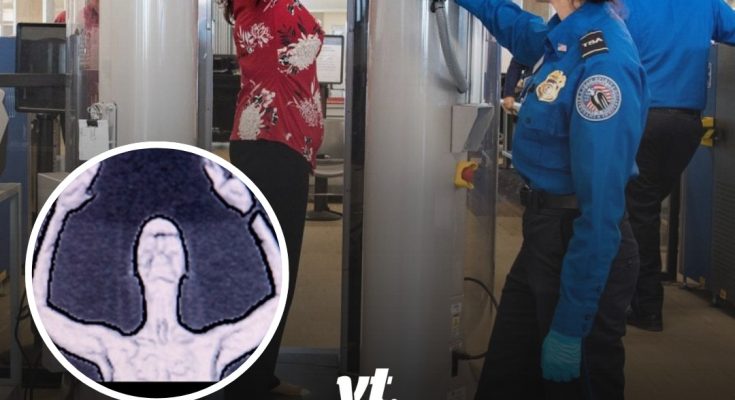Passengers have been horrified by the level of detail in airport security scans.

The Rapiscan X-ray was introduced at global airports after a failed terror attack took place on Northwest Airlines Flight 253, which had taken off for Detroit from Amsterdam on December 25, 2009.
A suspect named Umar Farouk Abdulmutallab tried to detonate explosives hidden in his underwear, resulting in serious burns and injuries to his groin and legs – but thankfully no explosion.
The terrifying incident sent shockwaves through the aviation industry and led to the US Transportation Security Administration (TSA) rolling out full-body scanners that revealed everything – from a traveler’s body shape to their private parts.
Naturally, this caused a major uproar as many decried them as “virtual strip searches,” according to CNN.
“If this isn’t an invasion of privacy I don’t know what is,” one horrified user commented, while another said: “There is no reason to fly if you can make it a road trip.”
In addition to this, many specialists raised concerns about the effectiveness and safety of these “nude” scanners, pointing out that the machines can expose people to low levels of radiation, which has been linked to cancer at higher doses, per NBC News.
Check out the old scanners below:.jpg_0V5MqU?tr=w-1024,cr-0.0.1024.1024&config=JTdCJTIybmFtZSUyMiUzQSUyMlRTQSUyMHNjYW5uZXJzJTIyJTJDJTIyZGVzY3JpcHRpb24lMjIlM0ElMjJUU0ElMjBzY2FubmVycyUyMiUyQyUyMmFsdGVybmF0aXZlX3RleHQlMjIlM0ElMjJUU0ElMjBzY2FubmVycyUyMiUyQyUyMmNhcHRpb24lMjIlM0ElMjJUaGUlMjBUU0ElMjBzY2FubmVycyUyMGNhdXNlZCUyMGJhY2tsYXNoLiUyMENyZWRpdCUzQSUyMENoaXAlMjBTb21vZGV2aWxsYSUyMCUyRiUyMEdldHR5JTIyJTJDJTIyY29vcmRpbmF0ZXMlMjIlM0ElN0IlMjJkZXNrdG9wJTIyJTNBJTdCJTIybGVmdCUyMiUzQTAlMkMlMjJ0b3AlMjIlM0EwJTJDJTIycmlnaHQlMjIlM0ExJTJDJTIyYm90dG9tJTIyJTNBMSU3RCUyQyUyMnRhYmxldCUyMiUzQSU3QiUyMmxlZnQlMjIlM0FudWxsJTJDJTIydG9wJTIyJTNBbnVsbCUyQyUyMnJpZ2h0JTIyJTNBbnVsbCUyQyUyMmJvdHRvbSUyMiUzQW51bGwlN0QlMkMlMjJtb2JpbGUlMjIlM0ElN0IlMjJsZWZ0JTIyJTNBbnVsbCUyQyUyMnRvcCUyMiUzQW51bGwlMkMlMjJyaWdodCUyMiUzQW51bGwlMkMlMjJib3R0b20lMjIlM0FudWxsJTdEJTdEJTJDJTIyd2lkdGglMjIlM0ExNTM1JTJDJTIyaGVpZ2h0JTIyJTNBMTUzNSU3RA==)
Due to the public outcry, TSA asked Rapiscan to develop a new software problem that corrected the issues. However, the company informed TSA that it would not be able to meet the June 2013 deadline it had set, so TSA declared that it would no longer use the controversial scanners.
“TSA has strict requirements that all vendors must meet for security effectiveness and efficiency,” the agency said. “Due to its inability to deploy non-imaging Automated Target Recognition (ATR) software by the Congressionally-mandated June 2013 deadline, TSA has terminated part of its contract with Rapiscan.
“By June 2013 travelers will only see machines which have ATR that allow for faster throughput,” the statement continued. “This means faster lanes for the traveler and enhanced security. As always, use of this technology is optional.”

At the time of the announcement, there were 174 Rapiscan body scanners. However, these scanners were gradually replaced with the less intrusive devices we see at the airports today.
Shawna Malvini Redden, a researcher and author of 101 Pat-Downs revealed to Reader’s Digest: “Early versions of the scanners came out without any privacy protections. Now, machines generate generic images instead of the passenger’s unique image.”
While airport security still isn’t the most relaxing experience, at least you don’t have to worry about the staff seeing your underwear anymore.
